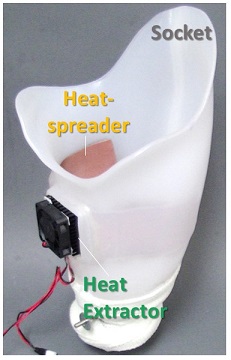Peer Reviewed Orthopaedic
Development of an Active Cooling System for Improving Residual Limb Skin Care



Posted June 12, 2017
Gordon Hirschman, M.Eng., Vivonics, Inc. and Todd Farrell, Ph.D., Liberating Technologies, Inc.

Improvised explosive devices encountered in modern warfare have caused a significant rise in traumatic amputations in the military population and an increased clinical need for prosthetics. Commonly used prosthetic liners limit air circulation and evaporation at the prosthetic socket interface. Inadequate heat and moisture management within the prosthetic socket often result in residual limb skin irritation, bacterial growth, and patient discomfort. Sweating and skin irritation can lead to skin diseases like dermatitis, ulceration, and psoriasis, among others. While these conditions can be successfully managed by care providers, they frequently result in reduced use of the prosthesis and a consequent reduction in patient's activity levels. Several attempts have been made to monitor and maintain lower skin temperatures within the prosthetic socket to reduce sweating. Unfortunately, most sensors and devices have proven to be excessively irritating to the skin, have limits to the amount of cooling they can provide, and/or can cause the socket/liner interface to fail to maintain a secure fit.
With an FY12 Peer Reviewed Orthopaedic Research Program Idea Development Award, Gordon Hirschman, Todd Farrell and their teams at Vivonics, Inc. and Liberating Technologies, Inc., aimed to develop an active cooling system that could be incorporated into lower-limb prosthetic sockets. The developed cooling system, Intra-socket Cooling Element (ICE), was designed to contain a heat pumping mechanism for active heat removal that would fit into the prosthetic limb socket. Results from initial human use studies showed that the custom-fabricated cooling sockets were able to decrease the temperature of the residual limb after exercise by an average three to five degrees Celsius, a clinically significant value, when compared with subjects who did not have the ICE. Users noted that ICE was as comfortable as their normal prosthesis and added that they would use ICE if it were available to them.
Promising early clinical results allowed Vivonics, Inc. and Liberating Technologies to file for a provisional patent in May 2016 ("Thermal management Device for a Prosthetic Socket"; US 62/344.758) and subsequent utility patent application. Additionally, follow-on funding through the Joint Warfighter Military Research Program (JWMRP) FY16 Military Medical Research and Development Award will enable Mr. Hirschman and Dr. Farrell to continue to further develop and commercialize the ICE active cooling system for lower limb prosthetic sockets. With this award, they aim to refine and optimize the system's conceptual design, finalize the design under FDA Quality Systems Regulations with ISO 13485 (Quality Management Systems) compliance, perform further validation testing of ICE, and to prepare for its commercialization. The ICE active cooling system has the potential to markedly reduce the incidence of skin irritation and breakdown, sores and infection experienced by individuals who wear prosthetic devices; improving the quality of life for these Service members, Veterans and Civilians.


Link:
Last updated Friday, December 13, 2024














